The PNY CS1311 and CS2211 SSD Review: MLC vs TLC at 15nm
by Billy Tallis on April 15, 2016 8:00 AM ESTMixed Random Read/Write Performance
The mixed random I/O benchmark starts with a pure read test and gradually increases the proportion of writes, finishing with pure writes. The queue depth is 3 for the entire test and each subtest lasts for 3 minutes, for a total test duration of 18 minutes. As with the pure random write test, this test is restricted to a 16GB span of the drive, which is empty save for the 16GB test file.
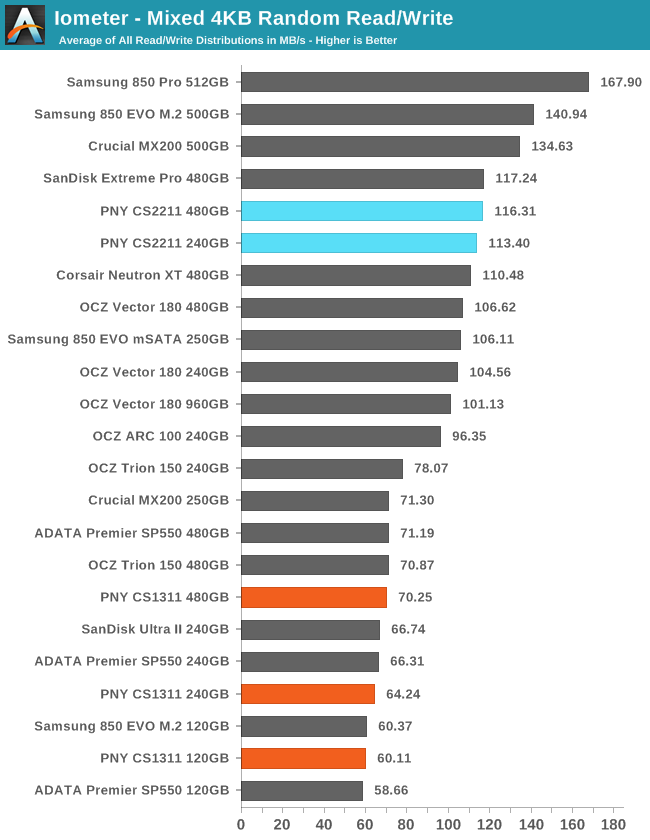
The mixed random I/O performance of the CS2211 is a little above average for MLC drives, while the CS1311 is pretty much at par for a planar TLC drive.
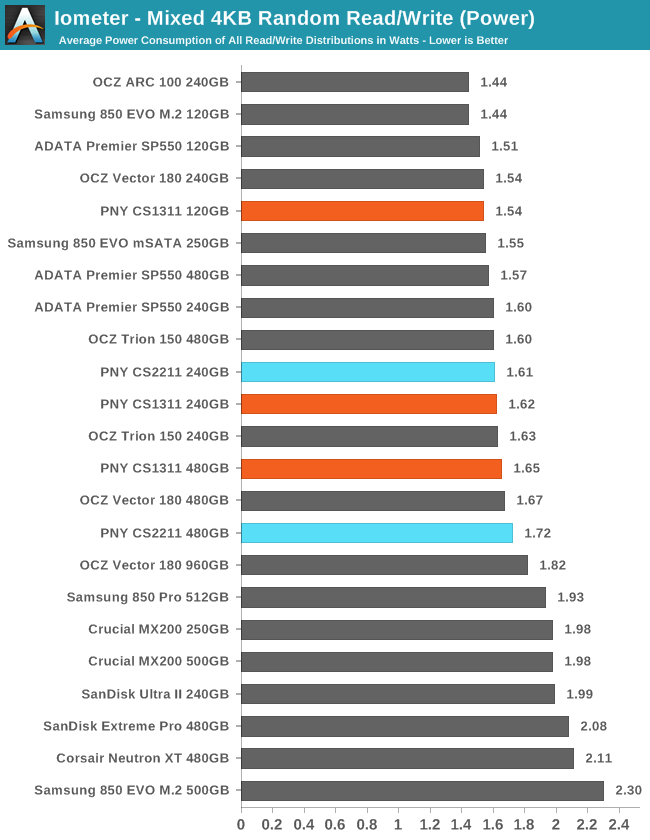
Power draw on the mixed random test follows the same patterns we've been seeing: the slowest and smallest drive draws the least power, while the largest fastest drive draws the most. All of the PNY drives are in the average range for power consumption, and the MLC drives are significantly more efficient.
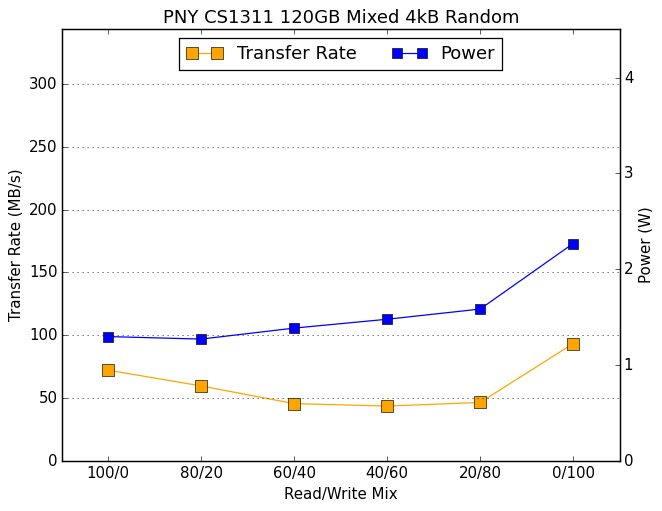 |
|||||||||
It's typical for power consumption to increase over the course of this test while performance bottoms out somewhere in the middle. The biggest difference in character between the TLC and MLC drives from PNY is that the MLC drives get a huge boost in the all-writes last phase of the test, bringing their average score way up.
Mixed Sequential Read/Write Performance
The mixed sequential access test covers the entire span of the drive and uses a queue depth of one. It starts with a pure read test and gradually increases the proportion of writes, finishing with pure writes. Each subtest lasts for 3 minutes, for a total test duration of 18 minutes. The drive is filled before the test starts.
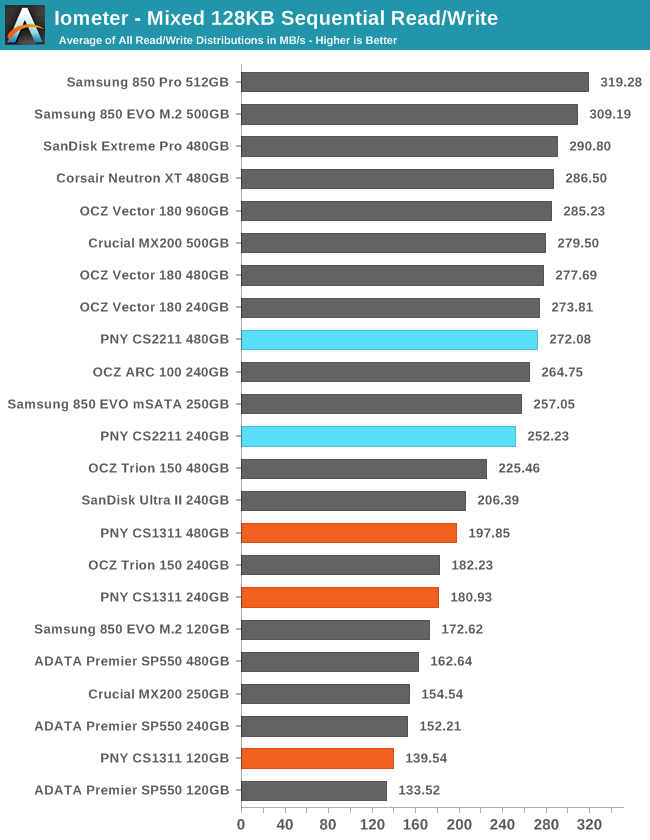
On the mixed sequential I/O test, PNY's drives range from slightly above average to second worst. The 240GB CS2211 in particular is underperforming a bit compared to its competition while the 480GB OCZ Trion 150 performs surprisingly well compared to the other TLC drives (including the 480GB CS1311).
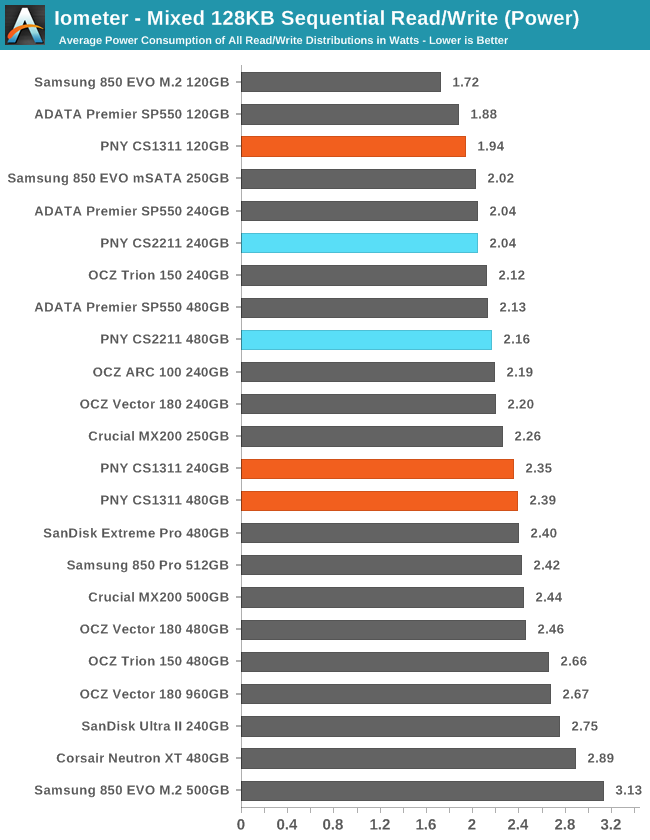
Both of the CS2211s average lower power consumption than the CS1311s of the same capacity, while the slower 120GB CS1311 again comes in as the least power-hungry of the batch (though its efficiency is nothing praiseworthy).
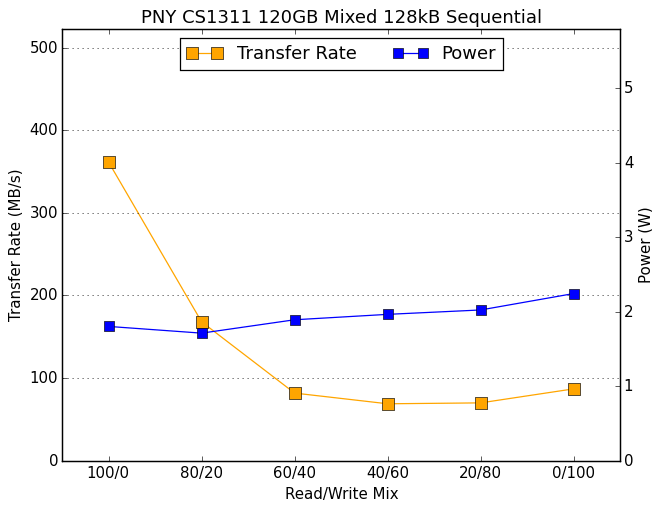 |
|||||||||
The key factor in the 120GB CS1311's low power consumption is its low performance on the pure-write phase of the test, which is an unsurprising result. The other CS1311s are large enough to deliver significantly higher performance on that part of the test, but they pay the cost in increased power draw.










43 Comments
View All Comments
DanoSpumoni - Saturday, April 16, 2016 - link
When 2TB SSDs drop below $200 then i'll bite... from the current trend it looks like thats only a couple years away maybe lesszodiacfml - Friday, April 15, 2016 - link
It has been like that ever since they unleashed V-NAND drives. Despite being on top, I think they are selling them competitively to remove or not allow smaller players to enter.zepi - Friday, April 15, 2016 - link
At least in Europe Samsung has priced itself out of the game completely. I've yet to see EVO ever even near the top of the GB per euro/£ list when I've been searching for drives. Usually Crucial seems to take to top stop and I've yet to see a reason buy anything else.Like now as I write I see 480GB BX200 being available for 97€ taxes included in amazon.de, cheapest 500GB EVO is 141€, so straight away +45% or something like that. I've yet to see it ever being even remotely competitive with sandisks or corsairs in Europe.
It still seems to sell well though being often in the top lists of many retailers.
DeepLake - Friday, April 15, 2016 - link
Last i checked US prices for Samsung EVO were also very high. I dont know what other commenters are talking about. Are they ignorant or Samsung agents?BrokenCrayons - Friday, April 15, 2016 - link
Thanks for the review. It's good to see SSD prices falling thanks to TLC and a standardized, inexpensive controller. I've been happy with the added capacity at a lower price point thanks to TLC flash. TLC performance behind budget controllers seems good enough now to make MLC SSDs a poor choice in a lot of desktop and laptop usage scenarios.haukionkannel - Friday, April 15, 2016 - link
So true. They Are slover, but the prises are good.hansmuff - Friday, April 15, 2016 - link
They make excellent game drives. With games coming in at 50GB at times, a 480 or 960GB TLC drive with so-so speeds is perfectly acceptable.bug77 - Friday, April 15, 2016 - link
I would love to see the SSD price fall fir any reason but planar TLC :(The performance of planar TLC is not that big of an issue, but the reduced lifetime is.
LostWander - Friday, April 15, 2016 - link
Is the reduced lifetime really that extreme? As far as I've seen it's still far better than anything you would get out of a conventional HDD. Adding in better general performance and it seems like less intensive applications (like a game or media storage drive) would still be perfectly acceptable for TLCbug77 - Friday, April 15, 2016 - link
You get 3 years warranty at most (two years less than MLC/V-NAND TLC) and something like 1000 p/e cycles. Good enough for many things (music, videos), but not if you're writing a lot (e.g. a system drive or a game drive).And while TLC itself is not so bad (it's hardly worth it imho, because it's not much cheaper), if the trend continues we'll have some pretty crappy drives in our hands soon.